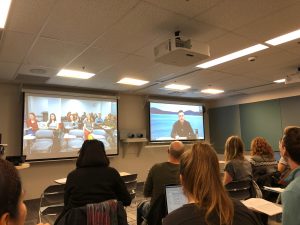 Week 11 ~ intro to distributed learning and guest speaker, Verena Roberts.
Week 11 ~ intro to distributed learning and guest speaker, Verena Roberts.
Michael met us via video-conferencing from the sunny shores of Tofino. Good times! In fact, he was next door using the video-conferencing. Michael did a great job of introducing the special guest for the morning.
Dr. Verena Roberts, whose @verenanz Twitter handle says she is a “K-12 & HEd Educator, Open Learner, Elephant in the Room Examiner”, video conferenced in to us to speak about Open Learning Design Intervention (OLDI). Unfortunately, the connection was not great and we had to cut the dialogue with Verena short. Below are my notes from what time we did get to spend with Verena and she kindly passed on her slides for further review.
Education technology and open ed possibilities
How many different ways an we teach beyond the classroom walls?
OLDI – Open Learning Design Intervention
What: K-12 students have opportunities to access people, context, gain ideas
Why: There are real and preconceived barriers to accessing digital networks outside K-12 classroom walls
How: Not all teachers have experiences open learning and they are looking for ideas and examples of expanding learning
Learning is learning
In classrooms be reflective
- Building relationships
- Co-designing learning pathways (teacher and student)
- Building and sharing knowledge
- Building PLN
Start in classroom > community > networks
Start with:
- How do I search and communicate online?
- Who is my online audience?
- How do I solve a community problem?
- What is my story and how does my story inform my identity?
Teach kids how to search online, how to read data and compare it to their own lives. Connect class to home life to make it relevant.
Distributed Learning
Classrooms have evolved from the face-to-face classrooms where if you’re there you’re there, and if you’re not, you’re not, to a more flexible style that breaks down those physical and spatial barriers to have classrooms that have different configurations than just having the holder of knowledge at the front of the class.
Consider the arguments against this recent Ontario government suggestion to take high school classes online: Mandatory online courses for high school students ‘a terrible idea’ experts say.
Today’s classrooms can include online environments where teachers are never seen in person, and all learning is done via chats, emails and skype to a blended learning environment where there is a mix of both in class and online learning.
Synchronous online classrooms and multi-access classrooms can help students who are not able to attend school in the traditional sense because of exceptionalities, physical health, learner needs, anxiety, physical barriers, remote/rural locations and time constraints. Opening up the classroom to a more flexible teaching style and environment does have many pros for those who can relate to the above comments.

Leave a Reply